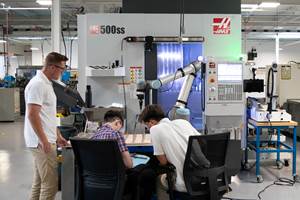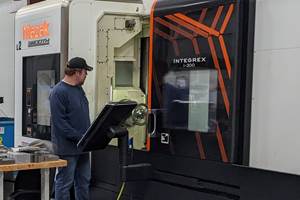California Specialty Machine Shop Expands High Precision Reputation
Though this company may be small, it has developed a reputation for its high-precision machining of exotic materials, since 1955.
Share





Maroney Company is a family-owned machine shop in Northridge, California, with only fifteen employees. Though this company may be small, it has developed a reputation for its high-precision machining of exotic materials, since 1955.
According to John Cameron, Maroney's President, "We earned a reputation as a precision EDM house soon after the company opened. By the late sixties, we were one of only a few in the Los Angeles area with this close-tolerance capability. At that time, TRW selected us to be sole supplier for E-ring and valve assemblies for the LEM descent engine that went to the moon on Apollo 11. From then on, our aerospace work took off."
Components made recently by Maroney for Jet Propulsion Laboratories (JPL) have recently landed on Mars with the Mars Pathfinder. Currently, the company is working with JPL to perfect what is described as the world's smallest spectrometer. Notes Mr. Cameron, "We wire-cut the part with a 0.001-inch diameter wire." In addition to work done for the U.S. government, they have also done some work for Disney's Imagineering Facility, making hydraulic actuators for the Pirates of the Caribbean attraction at several Disney theme parks.
However, Maroney is a prototype shop. Many parts the company makes are "one-offs," and ten or 12 pieces is a big production run. Mr. Cameron says, "Nearly all the parts we make are small enough to hold in your hand. We deal with materials from graphite and aluminum to exotic nickel alloys. Precision to plus or minus a tenth of a thousandth of an inch is commonplace."
The shop floor is where it all happens. Design and programming are done on two workstations, part of a UNIX system (with IGES and DXF compatibility), using CAD/CAM. All CNC machines on the shop floor are connected to the two design workstations by high-speed DNC link.
Back in 1978, Maroney bought its first BostoMatic CNC mill. Since then, they have purchased six more (four in 1996 alone). When the company decided to buy four more in 1996, they saw it as an opportunity to add to their already diversified capabilities. Today, BostoMatic machines include two Model 300s, a BD32, two Model BD18s, and a Model 505 five-axis machining center. All of the machines are equipped with half-micron glass scales. One of the machines has a high speed spindle.
Maroney bought its BostoMatic 505 five-axis machining center in mid-1996. "Until then we hadn't done much five-axis machining, but we're getting more involved in this kind of work," Mr. Cameron says. "We bought it to aid us in doing some operations, such as machining slant holes, in fewer setups and to simplify the machining of configurations that previously required separate operations. It offers us a new range of capabilities. Right now, the [Model] 505 is being used for some critical and very delicate work on the valve bodies that mix the hydrogen and oxygen in the propulsion system of the Space Shuttle. It is one of the largest parts we've ever done. We can do multiple operations without having to do multiple setups, which results in a more accurate workpiece.
Mr. Cameron notes that the Model 505 has a different capability than other five-axis machines they have in-house. Because the spindle head rotates about the tool tip, Abby offset errors are minimized. This special approach to five-axis machining minimizes the axis movements required to rotate the cutting tool in relation to the workpiece, dramatically shortens part program length, permits much higher feed rates, and increases accuracy by an average of six times over machines using compound rotary tables or other specialized five-axis equipment. Mr. Cameron comments, "This capability allows our operators to be more creative in solving machining problems." He adds, "One of the strengths of the new BostoMatic control is that it allows our operators to do a lot of the programming right at the machine."
Commenting on the large number of machines on Maroney's floor, Mr. Cameron goes on to say, " We're proud of our ability to handle a project from concept to completion with all the operations under our control. In many cases, by the time we get to delicate finishing operations on parts, there has already been a considerable investment made in them.
He summarizes, "Maroney's reputation as a specialty house for complex machining of precision components is on the line every day. BostoMatics play a key role in helping us maintain that reputation." MMS
Related Content
CNC Machine Shop Honored for Automation, Machine Monitoring
From cobots to machine monitoring, this Top Shop honoree shows that machining technology is about more than the machine tool.
Read More6 Machine Shop Essentials to Stay Competitive
If you want to streamline production and be competitive in the industry, you will need far more than a standard three-axis CNC mill or two-axis CNC lathe and a few measuring tools.
Read More5 Tips for Running a Profitable Aerospace Shop
Aerospace machining is a demanding and competitive sector of manufacturing, but this shop demonstrates five ways to find aerospace success.
Read MoreOrthopedic Event Discusses Manufacturing Strategies
At the seminar, representatives from multiple companies discussed strategies for making orthopedic devices accurately and efficiently.
Read MoreRead Next
Machine Shop MBA
Making Chips and 91±¬ÁĎÍř are teaming up for a new podcast series called Machine Shop MBA—designed to help manufacturers measure their success against the industry’s best. Through the lens of the 91±¬ÁĎÍř benchmarking program, the series explores the KPIs that set high-performing shops apart, from machine utilization and first-pass yield to employee engagement and revenue per employee.
Read MoreAMRs Are Moving Into Manufacturing: 4 Considerations for Implementation
AMRs can provide a flexible, easy-to-use automation platform so long as manufacturers choose a suitable task and prepare their facilities.
Read More





















